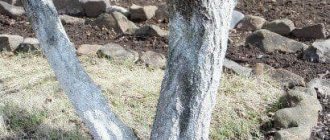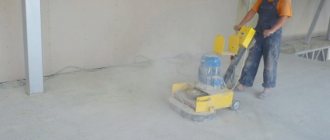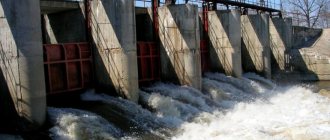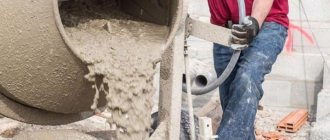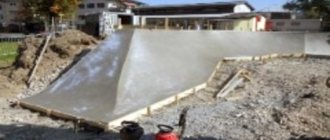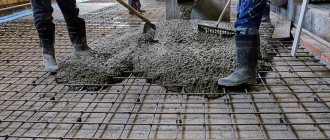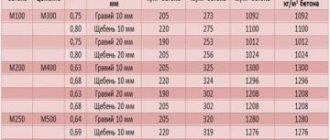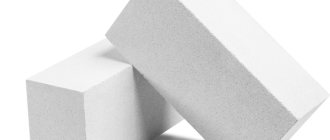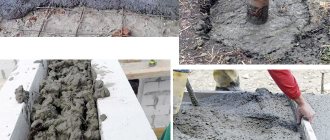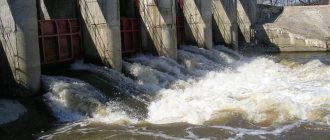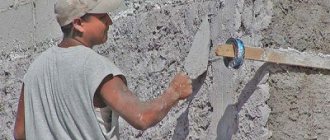Fiber-reinforced concrete - what is it?
Fiber-reinforced concrete is a fine-grained concrete mixture that contains reinforcing filler. Previously, due to the brittleness of the material and the presence of cracks, builders tried to increase strength by adding dispersed fibers. The elements were distributed throughout the solution, and as a result, the technical qualities were significantly improved.
Two types of fiber are used in production:
- metal - made of steel of various shapes and sizes;
- non-metallic - glass, cotton, polyethylene, acrylic are used as raw materials.
The structure of fiber-reinforced concrete is homogeneous; fibers made of different materials are located on all sides; the characteristics, as well as the effect of reinforcement, will depend on it.
Cost of fiber reinforced concrete
Fiber-reinforced concrete, the price of which may vary depending on the brand of material, has a certain fiber content per cubic meter. If this parameter is 30%, then the price of M-150 fiber-reinforced concrete will be 3,400 rubles. If the brand increases to M-200, then the price increases to 3,600 rubles. For the M-250 you will have to pay 3,700 rubles, while for the M-300 – 3,800 rubles. Fiber-reinforced concrete brand M-350 already costs 3,900 rubles.
Some companies today offer fiber-reinforced concrete with different fillers, which you can choose yourself or use the help of specialists in this matter. Ultimately, it will be possible to obtain a material that, for example, will have higher impact strength, water resistance, tensile strength and shear strength.
The price of fiber-reinforced concrete should not alarm you. It is so low because the production technology is not too complex. To make it, you just need to mix cement, sand, water and coarse aggregate like crushed stone. Among the ingredients there will be a certain amount of dispersed fibers called fiber.
Composition and technical characteristics of fiber-reinforced concrete
The characteristics of fiber-reinforced concrete depend on the building material used for production. The most common filler is steel fiber; it has excellent strength and does not shrink or crack during use. The advantages include the following qualities:
- long service life;
- density;
- wear resistance;
- moisture resistance.
In addition, fiber-reinforced concrete does not lose properties under the influence of high and low temperatures.
Glass fiber is popular among builders; it has excellent elasticity and ductility. But it does not tolerate an alkaline environment, so the material needs additional impregnation with polymer.
To do this, additives are added to the concrete, most often an alumina solution. It provides viscosity, so fiber-reinforced concrete is not damaged by exposure to an aggressive environment.
Asbestos fiber is durable, resistant to alkali and various loads. In addition, it has high thermal protective qualities.
Types and composition of fiber-reinforced concrete
Steel fiber concrete
Steel fiber, despite its apparent reliability, has many disadvantages - high weight, tendency to corrosion, low adhesion to concrete. Therefore, this type of concrete filler is not very common.
Basalt fiber concrete
Thanks to mineral basalt threads (GOST 14613–83), this type of fiber-reinforced concrete receives improved characteristics relative to steel reinforcement or conventional reinforced concrete. Characteristics such as resistance to mechanical loads, overall strength, resistance to fire, acids and alkalis are improved. In addition, temperature changes have almost no effect on the properties of the material. Whereas metal fiber has a high heat capacity and tends to expand and contract with temperature changes.
Therefore, this type of fiber-reinforced concrete is widely used for pile foundations and basement floors, as well as for decorating facades and small architectural forms.
Concrete with polypropylene fiber
Probably the weakest material in terms of mass of characteristics. It is afraid of temperature changes, is not reliable in terms of the composition of materials (usually recycled waste), and is low-adhesive. Nevertheless, even this type of fiber-reinforced concrete is significantly superior to ordinary, unreinforced concrete.
Cellulose fiber concrete
Cellulose is a specific filler that affects the resistance to acids and vapor permeability of the concrete being filled. It is used to slow down shrinkage processes, squeeze out liquid from the lower layers of the material, etc.
Carbon fiber concrete
Concrete mixed with pieces of carbon fibers has almost all the advantages of its analogues, and has only one significant drawback - its high price. Because of this, this type of fiber-reinforced concrete is less common than others. Therefore, the best alternative is often glass fiber concrete.
Fiberglass concrete
The production of glass fiber reinforced concrete (GFRC) differs from other fiber reinforced concrete only in the filler - glass fiber. It has almost all the best characteristics of other types of reinforcing materials, however, it has a very reasonable price. Thanks to its light weight, high adhesion, increased resistance to vibrations and resistance to chemicals, fiber-reinforced concrete on glass fiber has become an ideal material for the production of formwork and slabs from which bridges, tunnels, and overpasses are constructed. In particular, the famous “Crimean Bridge” was made using glass fiber reinforced concrete slabs and SFRC formwork, which were manufactured by our company.
Advantages and disadvantages
Fiber-reinforced concrete, like any other building material, has advantages and disadvantages. The positive aspects include the following:
- the use of fiber for reinforcement significantly reduces financial costs in construction, since there is no need to separately purchase reinforcing mesh or frame;
- the consumption of concrete mixture is reduced;
- Fiber-reinforced concrete has excellent adhesive qualities;
- the building material does not lose its technical characteristics even after the end of its service life, because the fiber acts on the material and it acquires a viscous structure;
- can be used in foam concrete and aerated concrete structures;
- fiber makes foam concrete more durable and reliable.
Reinforced composite has a longer service life than its counterparts. However, it does not lose its characteristics during this time.
Fiber-reinforced concrete also has a number of disadvantages. The main disadvantage is additional costs, since expensive raw materials are used in production. But all this pays off, since the resulting material will have unique performance properties, mechanical strength and durability.
Application
Fiber-reinforced concrete, the use of which is quite widespread today, is used in many areas of construction and industry. This is ensured by the high technical characteristics of the material. With its help, structures are made that have strict weight requirements. These can be buildings for domestic and industrial purposes.
Steel fiber reinforced concrete, for example, is used to make foundations, sleepers, bank protection strips, decks and bridges. This material is used in the construction of industrial tunnels and floors. If you add steel fiber to the ingredients, the material can ultimately be used in the construction of runways and in road construction, as well as laying sidewalks. Steel fiber concrete is also used as a high-strength coating. It is used to make borders and tiles.
Equipment for the production of fiber-reinforced concrete
Each individual material has its own technological process and equipment.
Fiber-reinforced concrete with the addition of steel fibers is produced using a powerful electromagnet. The element stretches the fiber while mixing the concrete solution. Electromagnetic installations vary in size and power.
To produce a solution with the addition of glass fiber, the pneumatic spray method is used. The principle of operation is the synchronous spraying of concrete and fiberglass, due to this, large-sized products with complex geometric shapes are produced.
Propylene fiber concrete can be made in a regular concrete mixer or using a construction mixer. The mixture mixes easily without forming lumps.
Fiber-reinforced concrete manufacturing technology
High-quality material can only be obtained through proper production. The technology must be strictly followed, regardless of where fiber-reinforced concrete is made - at a factory or in your own barn.
The manufacturing process directly depends on the type of fiber used, as well as on the proportions of the components that make up the concrete mixture. High density can only be achieved if the fibers in the solution are evenly distributed.
This uniformity determines how reliably the concrete structure will withstand external mechanical loads and chemical factors.
The production of the material takes place in several stages:
- prepare a solution;
- form fiber fibers, cut them to the required size;
- add elements to the mixture;
- mix thoroughly and compact;
- poured into molds;
- waiting for the monolith to harden.
Fibers used in production can be metallic or non-metallic. Fiber can also vary: steel fiber is cut from metal strips, glass fiber is formed from a straightened mass, and cellulose fiber is cut and rolled into a tube. Already in the process, it straightens out and creates a kind of grid in the concrete. The fiber must be distributed evenly.
If it is necessary to increase the plasticity of the material, then plasticizers are added. These elements control the contraction speed and regulate the level of shrinkage
Basic qualities
Fiber-reinforced concrete has a number of distinctive characteristics, among them the following should be highlighted:
- high tensile and tensile strength;
- resistance to weathering and chemicals;
- no shrinkage;
- waterproof;
- high plasticity;
- impact resistance;
- abrasion resistance;
- resistance to cracking;
- fire resistance;
- frost resistance;
- increased elastic modulus.
If you look at fiber-reinforced concrete in cross-section, it will be a homogeneous structure, which is penetrated throughout its entire thickness with thin fibers located in different directions. Depending on what type of fiber was used, the properties of concrete and the nature of inclusions will change.
Areas of use
Various additives are used during production, so you can easily change the properties of the final material. It all depends on what it will be used for.
Fiber concrete products
High-strength fiber-reinforced concrete is used for the manufacture of sculptures, rotundas and colonnades. Such structures are popular among builders and architects. This is due to the fact that the material is easy to work with. And it is preserved much better than similar species. It is not afraid of negative climatic conditions in the form of rain and snow, since concrete does not lose its original appearance.
Industrial engineering
The presence of steel wire in the composition provides high strength. This material is used in the construction of the following objects:
- structures made of monolithic reinforced concrete;
- hydraulic structures;
- water treatment plants;
- underground highways.
Fiber-reinforced concrete is used in the construction of transport tunnels. The material is also irreplaceable in the construction of underground drainage structures.
Fiber-reinforced concrete facade panels
Increasingly, facade panels made of fiber-reinforced concrete are used for cladding buildings. They are quickly installed, lightweight, low in price and have high technical performance.
A significant advantage is that you can choose a material that will imitate wood, stone or brick.
The front side of the panels is treated with a special compound that is resistant to moisture and a number of other harmful atmospheric phenomena.
Fiber concrete steps
Fiber-reinforced concrete linings are a facing material for marching structures. Such steps are distinguished by a high level of quality, strength and reliability.
In addition, the material will give a noble look to simple flights of stairs. The panels are easily mounted on a work surface, so you can install them yourself.
Fiber concrete decor
Concrete containing glass fiber is used in various fields. More often the material is used for the production of decorative elements related to the decoration of landscape design, fences, and canopies.
The solution is also suitable for making and covering benches, flower beds, flower beds and other types of household fixtures.
Other products
Fiber-reinforced concrete is used to make paving and road surfaces, as well as decorative tiles and borders.
Recently, it has been used to create the foundations of airfields, railway sleepers, and bridges, since the material can withstand maximum loads.
Application of composite fiber concrete
The qualitative composition and use of fiber-reinforced concrete must comply with the requirements of regulatory documents SP 52–104–2006 Steel fiber-reinforced concrete structures. The set of rules contains recommendations for the design and standards for the use of fiber-reinforced concrete structural products.
In housing construction, composite concrete is used for the construction of monolithic building structures, drainage shafts, sewer wells, etc. Fiber-reinforced concrete floors made using composite technology have high strength and increased thermal insulation properties.
Fiber concrete floors
